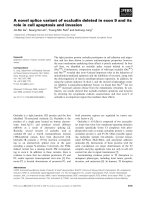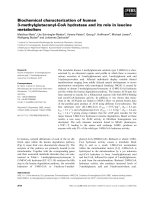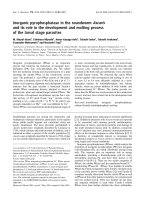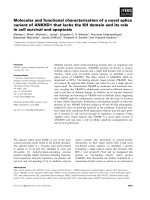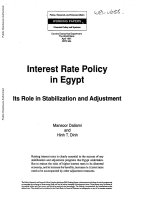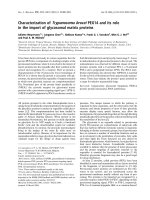METAPHOR AND ITS ROLE IN ENGLISH VOCABULARY LEARNING AND TEACHING
Bạn đang xem bản rút gọn của tài liệu. Xem và tải ngay bản đầy đủ của tài liệu tại đây (122.19 KB, 14 trang )
HA NOI, VIET NAM NATIONAL UNIVERSITY
COLLEGE OF FOREIGN LANGUAGES
FALCUTY OF POSTGRADUTE
METAPHOR AND ITS ROLE IN ENGLISH
VOCABULARY LEARNING AND TEACHING
SEMANTICS
(FINAL ASSIGNMENT)
Supervisor:
Dr. Hà Cẩm Tâm
Student:
Nguyễn Thị
Phương
Class:
Deadline:
Ha Noi June / 2010
K18C
28 / 06 /2010
CONTENT
1. INTRODUCTION
1-2
2. DEVELOPMENT
2.1 Definitions of metaphor
2-3
2.3 Functions of metaphor
3-5
2.2.1 Naming function
4
2.2.2 Cognitive function
4
2.2.3 Symbolic function
5
2.3 Kinds of metaphor
5-7
2.3.1 Living metaphors
5-6
2.3.2 Faded metaphors
6
2.3.3 Dead metaphor
6-7
2.4 Role of metaphor in English vocabulary learning 7-9
and teaching
2.5 Implications for English vocabulary learning and 9-10
teaching
3. CONCLUSION
10
CONTENT
1. PORTFOLIO 1: INTRODUCTION TO RESEARCH
IN APPLIED LINGUISTICS
2. PORTFOLIO 2: EXPERIMENTAL RESEARCH
3. PORTFOLIO 3: ETHNOGRAHIC RESEARCH
4. PORTFOLIO 4: SURVEY RESEARCH
5. PORTFOLIO 5: CASE STUDY
6. PORTFOLIO 6: ACTION RESEARCH
7. PORTFOLIO 7: CONDUCTING A RESEARCH
PROJECT
8. PORTFOLIO 8: PREPARING AND WRITING A
THESIS AND UNDERTAKING A VIVA
1. INTRODUCTION
Metaphor is both a phenomenon of language and of thought. It plays an
important role in humans’ understanding the world, the forming of the conceptual
structure and the development. It is a higher stage of cognitive development.
Metaphor is common and pervasive not just in English but in all languages and
across all dialects and it appears in literary as well as everyday language. Studies
of metaphor have taken on an absolutely new look over the past decades,
evidenced by Metaphors We Live by collaborated by Lakoff and Johnson (1980),
which has rocked to the core studies of metaphor in linguistic field, attributing to
their interpretation of metaphor system in the line of cognition named modern
metaphor and proposes that metaphor is a matter of thought and action rather than
a device of poetic imagination and the rhetoric flourish. In addition, Kovecses
(1986) presents a demonstration that emotions such as anger, pride and love are
conceptualized structure in everyday language. All these studies illustrate the
cognitive idea of metaphor, for instance, metaphor mediates human understanding
and world view (Lan, 2005). However, there have not been many studies of
metaphor in foreign language learning and teaching. As a teacher of English, I see
that metaphor plays a really important role in learning and teaching foreign
language, especially vocabulary. So I decide to choose the topic “Metaphor and
its role in English vocabulary learning and teaching”. In this paper, I will mainly
focus on the review of metaphor and its role in vocabulary learning and teaching.
Firstly, the paper introduces the review of metaphor that consists of definitions of
metaphor, functions of metaphor and kinds of metaphor. And then the paper
discusses the role of metaphor in extending the senses of the same word forms,
conceptualizing abstract vocabulary categories and word forming.
2. DEVELOPMENT
2.1 Definitions of metaphor
The term metaphor that comes from the Greek means “transference”. As it
is stated by Vo Dai Quang (2003: 33), metaphor is “word meaning transference
based on similarity between two things as regards function, character, size, shape,
age, colour, ect.” Take the following example.
E.g. Tom is a snake.
In this example, the word “snake” has a negative connotation as snakes are
thought to be very poisonous or dangerous to people. So this meaning is
transferred to refer to the character of a person (Tom) to imply that he is a
dangerous person. The similarity in this case between an animal (snake) and a
person (Tom) is about the character. So this definition of metaphor is very clear
and detailed.
However, the question “why do people have to use such an implicit way to
convey the idea”. This is clearer in the definition given by Oxford Advanced
Learner’s Dictionary (1995: 734) in which metaphor is defined as “the
imaginative use of a word or a phrase to describe somebody/something as another
object in order to show that they have the same qualities and as to make the
description more forceful”. This definition is not as detailed as the abovementioned definition about the association of similarity but it takes the use and the
effect of metaphor into consideration. If we say “Tom is a dangerous person”, it is
not as forceful to the hearer as we say “Tom is a snake”. Also, metaphor can
convey the imagination of the language users so it is obviously more persuasive
and effective in communication.
From the linguistic point of view, metaphor is defined as “an extension in
the use of the word beyond its primary meaning to describe referents that bear
similarities to the word’s primary referent” (Language – its structure and use,
1994). The term “extension” refers to the meaning of the word that can be
expanded beyond its literal meaning. So metaphor here is treated as a means of
creating and extending meaning to describe other referents which are similar to the
word’s primary referent. Look at the above example again. The primary referent of
the word “snake” is one kind of animal and in this metaphor, it refers to another
referent that is a dangerous person (Tom). This can be done on the basis of the
resemblance between the two referents.
According to Barcelona (2000: 3), “metaphor is the cognitive mechanism
whereby one experiential domain is partially mapped or projected onto a different
experiential domain so that the second domain is partially understood in terms of
the first one”. So metaphor in this definition is understood as a conceptual
projection whereby one experiential domain is understood in terms of another. In
the above example, the character of a person (Tom) is likened and understood in
terms of a character of a snake.
In general, metaphor discussed above is viewed from different angles. To
put it simply, it is the way we call one object by the name of another because we
compare these objects and find some common features between them.
2.2 Functions of metaphors
Metaphors are of various values and functions in language, however, in this
study only three basic functions given by Dinh Trong Lac (1994:53), a Vietnamese
linguist, are mentioned. According to his opinion, there are three basic functions of
namely naming, cognitive and symbolic functions and basing on this he can group
metaphors together.
2.2.1 Naming function
The first function of metaphors is to name things. This is only the technical
means to use the ready-made vocabulary to give names to other things basing on
the resemblance between them. For example, the lowest part the mountain is
called the foot of the mountain as the foot on the human body is the lowest part.
These metaphors are of almost no or very little rhetoric value but they can reflect
the way in which things in the world are viewed together. These metaphors are
only intended to give names to things basing on the experience with the existing
vocabulary.
2.2.2 Cognitive function
The second function of metaphors is to cognize or to conceptualize things.
Here the metaphors do not give new names to things but conceptualize them in
terms of another. Moreover, metaphors operates between two domains, one
domain is conceptualized in terms of another. For example, in the domain of
weather, when it is sunny, the sun is shining and brings pleasant weather that can
make people happy and comfortable. So the word “sunny” has positive
connotation and it is transferred to talk about the mood of people as in the
following example.
E.g. By the time he reached the outskirts of Cambridge, David was in a
sunny mood.
That is, David felt very happy and optimistic. In this way, the human mood
is conceptualized and understood under the words about weather. These metaphors
are also conventional and of little rhetoric effect.
2.2.3 Symbolic function
The last function of metaphors mentioned here is to symbolize things. This
function is commonly thought to be the conventional function of metaphors. For
instance, the flower often symbolizes for the beauty. So it is often compared to the
woman’s beauty.
E.g. Beauty is a flower which wrinkles will devour.
In this example, the flower is compared to the beauty of people that will
devour like the flower. Metaphors of this group reflect the imaginative and
creative way that individuals judge and comment things, which can make their
language more expressive and more persuasive. They are very popular in poetic
language.
On the whole, metaphors carry three major functions in language which are
naming, cognitive and symbolic functions.
2.3 Kinds of metaphors
Metaphors, like any other stylistic devices, can be classified according to
their degree of unexpectedness. As it is stated by Nguyen Hoa (2004: 109), basing
on the degree of unexpectedness, there are three main types of metaphors namely
living metaphors, faced metaphors and dead metaphors.
2.3.1 Living metaphors
Metaphors which are unexpected and quite unpredictable are called living
metaphors. In these metaphors the word has an unusual metaphorical sense that is
easily recognized by the hearer. They are created and used by individuals.
E.g. You are my sun.
It can be seen that the sun lights our earth by day, which can makes people’s
life brighter and happier. So when a person who is thought to make the other’s life
brighter and happier is considered “the sun”. The metaphors of this type are also
called creative or poetic metaphors as it reflects the creative use of language and
they are attached to the symbolic function as discussed above and are especially
used in literature and poetry. They are not common in everyday language usage.
Sometimes, they are called genuine metaphors because it is the common sense
when people talk about metaphors and they have great rhetoric effect on the
hearer.
2.3.2 Faded metaphors
Faded metaphors are those which have lost their freshness because of long
and traditional use and become habitual in daily language usage. For instance,
gold is one kind of very valuable material and the adjective “golden” denotes
something made of gold. And when people say “golden youth”, they imply that the
youth in a person’s life is also as valuable as gold. Metaphors are so common in
everyday language that they are sometimes not felt as metaphors. These metaphors
can cause polysemy of so many words in language. Among the functions
discussed, they are attached to the naming and cognitive functions.
2.3.3 Dead metaphor
Dead metaphors are those whose metaphorical sense is not felt at all
because they have lost their indirect meaning and are only used figuratively. For
example, the word “capital” in English used to mean the head which are
considered as the most important part on the human body. So it was
metaphorically used to refer to the most important city or town of a country which
is usually the centre of government. But now the word “capital” is not used
literally as the head of the human body but only means the capital of the country
as in the sentence: “Hanoi is the capital of Vietnam”. These metaphors are not
many in language. In fact, they are different or almost impossible to be recognized
as metaphors.
Generally, there are three types of metaphors which are living, faded, and
dead metaphors.
2.6. Role of metaphor in vocabulary learning and teaching
2.6.1 Extending the senses of the same word forms
According to Fachun Zhang & Jianpeng Hu (2009. P 80), conceptual
metaphors provide us with the possibility of seeing one thing in terms of another.
This feature enables us to link the senses of a lexical item in one domain to its
related metaphorical senses in another domain, thus extending the senses of the
same word forms. For example, the word ‘shaky’ in the building domain can be
used in the theory domain with the linking conceptual metaphor theories are
buildings or the word ‘remote’ in the distance domain can be used in the
relationship domain with the linking conceptual metaphor relationship is distance
and most importantly, a large number of words can be learned systematically in
this way.
In pedagogical practice, teaching of extending the meanings of lexical
items can be conducted in the following way. To begin with, the teacher can give
such an example as follows:
E.g. Jim and Lily are lovers while Jim abandoned Lily and fell love with
another girl, so Lily felt wounded by Jim’s betrayal and she had never been
stabbed in the back like that before. She was badly hurt.
In teaching sentences of such kind, the teacher can guide the students to
find the two domains. For instance, the teacher can guide the students to find the
two domains by asking questions like “can wounded be used on other occasions
and what is the normal use of hurt”. Gradually, the students would be guided to
the physical domain of the words wounded and hurt. The expected conceptual
metaphor to be established is negative emotions are physical pains. Therefore, a
mapping relation like the following can be established.
Negative emotions are physical pains. In this activity, students are guided to
search for the different senses of the same word forms, to link one domain to
another, and eventually to find the potential conceptual metaphors linking these
two topic domains. In this way, students can easily memorize the meanings of a
word.
In short, in order to extend learners’ account of vocabulary, teachers should
use metaphor in vocabulary teaching as much as possible.
2.6.2 Conceptualizing abstract vocabulary categories
Metaphor is not just a figure of speech, but a way we perceive the world.
“Language is essentially metaphoric”, because metaphor is widely used in our
daily life, lives in our language, is in our thought and behavior. As John and
Lakoff (1980) note that the conceptual system that our thought and behavior rely
on is metaphoric in nature. In the same sense, metaphor is an important way of
language change and development. We can feel metaphor everywhere, at any time,
since it is a way of thinking. So it will be a good try to teach English vocabulary
by making use of metaphors. They are powerful cognitive tools for our
conceptualization of abstract vocabulary categories. The most important feature of
metaphor is its relatedness between things and categories. For example, the word
“leg” can be used to refer to legs of human beings, legs of a chair, a bed, a table,
and so on, which basically means “the support of things”. (Yanqing Chen. 2009. P
99).
In belief, in vocabulary teaching and learning, we should try every possible
means to develop metaphorical awareness, make full use of the cognitive function
of metaphor and reveal the metaphorical relationship between word meanings.
2.6.4 Forming words
In the study of Zou Jiahui (2008. P265), in the first data collection, he
randomly chose 328 new words from the dictionary. They are 231 nouns and 61
adjectives, 34 verbs and 2 adverbs which are open-class words. With the
emergence of new ideas, inventions, ect., new expressions are continually and
constantly being added to the lexicon. They are in infinite or unlimited (Hu,
2001:81). Most of the meanings of new words are formed metaphorically. It is no
doubt that people usually understand the new things with metaphorical cognition
mapping from the odd and familiar domain to the new and unfamiliar domain by
which the meanings of the new words are formed, which is the main way of
forming new words. The number of words is limited, but the human cognition is
unlimited. So man can use the limited words to express the endless world by
metaphorical cognition. That is the main source of the new words.
In belief, I see that using metaphor in vocabulary learning and teaching is
also one of the ways to expand account of vocabulary, so it is essential for both
teachers and learners to apply it to their teaching and learning.
To sum up, metaphor plays a really important role in English vocabulary
learning and teaching. It not only helps extend learner’s vocabulary through
metaphorical awareness but also it is a useful tool for conceptualizing abstract
vocabulary categories. In addition, the leaner can use metaphor for forming new
words. So, the teacher as well as the learner should use metaphor when teaching
and learning vocabulary.
2.7 Implications for teaching and learning
Basing on the review of metaphor and its role, I would like to give some
implications as follows.
It is worthwhile to draw L2 EFL instructors’ attention to the important role
of metaphor as a device for vocabulary teaching and learning. This paper has
attempted to show that metaphors may have a useful function in teaching by
helping to raise L2 learners’ awareness of expanding their account of vocabulary.
Thus teachers of foreign language should well know new discoveries in study of
metaphors and elaborate on theoretical basis behind linguistic phenomenon of
various kinds and recognize the bits and pieces of language phenomenon into a
whole by dint of metaphor theories.
In addition, familiarity to the foreign language may be facilitated, if not
accelerated, by developing to the metaphorical concepts that underlie the target
language. Teachers of English as a foreign language need to provide tools and
strategies to their learners to help them effectively build semantic memories of the
words and phrases in the target language. The effectiveness can only be judged to
the extent such knowledge of words and phrases are retained in long-term
memory.
Moreover, metaphor is a very abstract concept, so as language teachers, we
need have deep understanding of metaphor and raise learners’ awareness of using
metaphor in language learning.
Furthermore, because metaphor has an important role in English vocabulary
learning, learners should pay more attention to this. They need to apply it to
learning vocabulary as well as other language skills.
In general, teachers as well as learners should have deep understanding of
metaphor in order to use it effectively in foreign language learning and teaching.
3. CONCLUSION
In conclusion, metaphor is an avenue of cognizing the world and has
penetrated every nook and corner of our daily life, thus having immense impact on
our thinking patterns. However, in this paper, I only give a brief review of
metaphor and its role in English vocabulary learning and teaching. I hope that this
paper will help the teacher as well the learner has an overview of metaphor
theories and its role in English vocabulary teaching and learning. However,
because of limited time, I cannot conduct a real research. I believe that I can do
this in the next time. I hope that there will be further studies of this issue in the
future.
REFERENCES
1. Lakoff, G. and M. Johnson. (1980). Metaphors We Live By. Chicago:
University of Chicago Press.
2. Kovecses, G. (1986). Metaphors of Anger, Pride and Love.
Amstendam:Benjamins.
3. Nguyen Thi Yen Thoa (2005). A Contrastive Analysis of Metaphor Relating to Parts of
Human Body In English and Vietnamese. M.A Minor Thesis Linguistics: 5.04.09
4. Yanqing Chen (2009). A Cognitive Linguistic Approach to Classroom English
Vocabulary Instruction for EFL Learners in Mainland China. English
Language Teaching – www.ccsenet.org/journal.html.
5. Fachun Zhang & Jianpeng Hu (2009). A Study of Metaphor and its Application
in Language Learning and Teaching. International Education Studies –
www.ccsenet.org/journal.html.
6. Quang, Vo Dai (2003). Semantics. Vietnam National University, College of
Foreign Languages.
7. Crowther J. (1995). Oxford Advanced Learner’s Dictionary. Oxford University
Press.
8. Dinh Trong Lac (1994). Tu Từ Tiếng Việt. Nhà xuất bản giáo dục.
9. Language – its structure and use (1994).
10. Nguyen Hoa (2004). Understanding English Semanics. Nhà xuất bản giáo dục.

